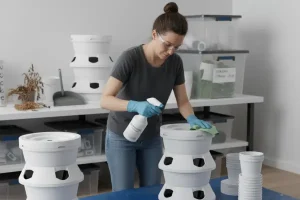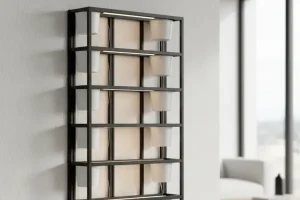Not all vertical gardens have the luxury of full sunlight. If your setup is indoors, on a shaded balcony, or in a basement grow space, LED grow lights can make the difference between struggling plants and thriving blooms. But with so many types of grow lights available, how do you know which fixtures are right for your vertical wall?
This guide will break down the basics of LED grow lights, how to choose the best type for your garden, and what mistakes to avoid.
Before you shop, think about light like “food” for your wall: how much, what kind, and where it lands. Vertical gardens benefit from slim bar-style LEDs that spread light evenly top to bottom, or modular panels you can stagger along the height of the wall.
Aim for a full-spectrum fixture (400–700 nm) with 3000–5000K white for natural color, and target PPFD ~150–300 μmol/m²/s for leafy plants and 250–500 for flowering crops. Mount lights 8–18 inches from foliage, run them 12–14 hours daily, and add a timer so schedules stay consistent. Check heat output and wattage—efficient LEDs keep bills low and won’t overheat small rooms.
Why LED Grow Lights Matter
Plants turn light into energy through photosynthesis, so the right lighting is as important as water and nutrients. In vertical gardens, shelves and foliage cast shadows, which means:
- Lower rows often get less sunlight than upper ones.
- Indoor setups may receive too little natural light for steady growth.
- Consistent, targeted lighting produces stronger roots, healthier leaves, and more blooms or fruit.
LEDs (light-emitting diodes) solve these challenges because they:
- Use far less electricity than older bulbs, cutting operating costs.
- Run cooler, so leaves don’t scorch—even at closer distances.
- Offer tunable spectra (full spectrum or bloom/veg emphasis) to match your plants’ stage.
- Provide even light with slim bar fixtures that spread coverage top to bottom.
- Last a long time (often 25,000–50,000+ hours), reducing replacements.
- Include dimming and timers for precise schedules and gradual acclimation.
Step 1: Understand Light Spectrum
Plants respond to different wavelengths of light:
- Blue light (400–500 nm): Promotes leafy growth.
- Red light (600–700 nm): Encourages flowering and fruiting.
- Full-spectrum LEDs: Combine red, blue, and white light to mimic sunlight.
For vertical walls, full-spectrum LEDs are usually the best choice, since they support plants at all stages.
Step 2: Match Light Strength to Your Garden
Light strength is measured in PPFD (Photosynthetic Photon Flux Density), but you don’t need to memorize technical charts. Instead:
- Leafy greens & herbs: Do well with lower light levels.
- Flowering plants & fruiting vegetables: Need higher intensity.
Rule of thumb:
- Indoor decorative walls (ferns, pothos, small flowers): 15–30 watts per square foot.
- Edible vertical walls (lettuce, strawberries, tomatoes): 30–50 watts per square foot.
Step 3: Choose Fixture Types
- LED Light Bars: Long and narrow, perfect for evenly lighting vertical panels.
- LED Panels: Provide strong, wide coverage for large walls.
- Clip-on Lamps: Great for small towers or spotlighting specific plants.
- Modular Systems: Customizable, allowing you to expand as your garden grows.
Step 4: Placement & Setup
- Place lights 6–18 inches from plants, depending on light strength.
- Mount bars or panels vertically or diagonally for even coverage.
- Use timers to provide 12–16 hours of light per day, depending on plant type.
- Rotate plants occasionally to prevent uneven growth.
LED Fixture Quick Guide
| Fixture Type | Best For | Pros | Cons |
| Light Bars | Vertical panels | Even coverage, slim design | Limited individual intensity |
| LED Panels | Large walls/towers | High output, wide coverage | Higher upfront cost |
| Clip-on Lamps | Small indoor towers | Flexible, affordable | Covers small areas only |
| Modular Systems | Expanding gardens | Customizable, scalable | Setup takes more planning |
Common Mistakes to Avoid
- Using household LEDs – not strong enough for plant growth.
- Placing lights too far away – reduces effectiveness.
- Overexposure – too much light can stress plants; use timers.
- Ignoring lower rows – plants at the bottom often get shaded.
FAQs
Q: Can I use regular white LEDs instead of grow lights?
No. Regular LEDs lack the right spectrum for healthy plant growth.
Q: How many hours should lights run daily?
12–16 hours is ideal for most plants. Use a timer for consistency.
Q: Will grow lights increase my electricity bill?
LEDs are energy-efficient. Even running daily, costs are usually just a few dollars per month.
Q: Do I need different lights for flowers vs. vegetables?
Not if you choose full-spectrum LEDs. They work well for all plant types.
Next Steps & Related Reading
For water management, read How to Select the Right Water Pump for Your Vertical Garden.
If you want more automation, check out Installing & Calibrating pH and EC Meters in a Vertical System.
Conclusion
LED grow lights are one of the smartest investments for vertical gardening, especially indoors. By selecting the right spectrum, wattage, and fixture type, you can keep your vertical wall healthy, colorful, and productive year-round.
Would you choose slim light bars for subtle coverage, or powerful LED panels for maximum growth?




